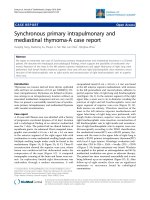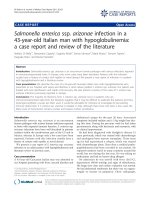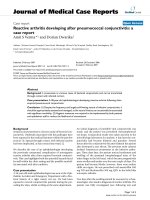Báo cáo y học: " Successful long-term monotherapy with rituximab in a patient with chronic lymphocytic leukemia of the B-cell-lineage: a case report" pdf
Bạn đang xem bản rút gọn của tài liệu. Xem và tải ngay bản đầy đủ của tài liệu tại đây (486.42 KB, 5 trang )
BioMed Central
Page 1 of 5
(page number not for citation purposes)
Journal of Medical Case Reports
Open Access
Case report
Successful long-term monotherapy with rituximab in a patient with
chronic lymphocytic leukemia of the B-cell-lineage: a case report
Isrid Sturm*
1
, Joachim Oertel
1
, Stephan Oertel
2
, Jörg Westermann
1
and
Antonio Pezzutto
1
Address:
1
Department of Hematology and Oncology, Charité Campus Virchow-Klinikum, Augustenburger Platz 1, 13353, Berlin, Germany and
2
Roche Pharma AG, Emil-Barrell-Str. 1, 79639, Grenzach-Wyhlen, Germany
Email: Isrid Sturm* - ; Joachim Oertel - ; Stephan Oertel - ;
Jörg Westermann - ; Antonio Pezzutto -
* Corresponding author
Abstract
Introduction: Treatment of chronic lymphocytic leukemia of the B-cell-lineage is strongly based
upon clinical staging because of the heterogeneous clinical course of this disease.
Case presentation: We describe a 62-year-old patient with newly diagnosed chronic
lymphocytic leukemia of the B-cell-lineage who did not respond to several chemotherapy regimens
including chlorambucil, fludarabine and cyclophosphamide, developing a marked neutropenia and
thrombocytopenia with life-threatening infections. Further chemotherapy appeared not feasible
because of bone marrow toxicity. The patient was treated with 600 mg/m
2
rituximab weekly
followed by eight courses of biweekly therapy and then by long-term maintenance therapy,
achieving almost complete remission of the symptoms and disease control.
Conclusion: After resistance to standard chemotherapy with chlorambucil and fludarabine, a
patient with chronic lymphocytic leukemia of the B-cell-lineage was successfully treated with
rituximab.
Introduction
Chronic lymphocytic leukemia of the B-cell-lineage (B-
CLL) is the most common form of adult leukemia and
predominantly a disease of older individuals. Due to the
strong heterogeneity in the clinical course of B-CLL with
survival ranging from months to decades, treatment regi-
mens are strongly based upon clinical staging. Although
recent data show that cytogenetic profiling of tumor cells
and flow-cytometry characterization of certain surface and
intracytoplasmic proteins have strong predictive value,
treatment regimens are still strongly influenced by clinical
parameters such as clinical presentation, laboratory values
or lymphocyte doubling time [1].
CLL is generally treated at the onset of symptomatic dis-
ease, and initial treatment includes alkylator therapy
(chlorambucil or cyclophosphamide) or purine nucleo-
side analogs, such as fludarabine alone or in combination
with cyclophosphamide. Rituximab is a humanized
murine monoclonal antibody directed against the B-cell
surface protein CD20 and is active against most B-lineage
lymphoid malignancies, including CLL. Initially, the use
Published: 14 August 2008
Journal of Medical Case Reports 2008, 2:275 doi:10.1186/1752-1947-2-275
Received: 29 November 2007
Accepted: 14 August 2008
This article is available from: />© 2008 Sturm et al; licensee BioMed Central Ltd.
This is an Open Access article distributed under the terms of the Creative Commons Attribution License ( />),
which permits unrestricted use, distribution, and reproduction in any medium, provided the original work is properly cited.
Journal of Medical Case Reports 2008, 2:275 />Page 2 of 5
(page number not for citation purposes)
of rituximab in CLL was considered unsafe because of
severe toxic reactions from tumor cell lysis in patients with
very elevated blood cell counts [2]. Here we describe a
patient with B-CLL, who did not respond to prior chlo-
rambucil and fludarabine chemotherapy developing a
marked marrow toxicity to fludarabine, but was success-
fully treated with rituximab.
Case presentation
A 62-year-old Caucasian woman (61 kg/160 cm) was first
diagnosed with B-CLL stage Binet A/Rai 0 in July 2002.
She showed marked leukocytosis with a white blood cell
(WBC) count of 43.35 × 10
9
/l (82% lymphocytosis),
accompanied by slight anemia (hemoglobin 11.1 g/dl)
and a platelet count of 129 × 10
9
/l. Flow cytometric
immunophenotyping (Fig. 1) of peripheral blood identi-
fied a CD5/CD19/CD20/CD23-positive clonal B lym-
phocyte population with kappa light chain expression
and sIgM expression. CD10/CD103/CD38/CD43/CD22
and FMC7 were all negative. A chromosomal fluorescence
in situ hybridization (FISH) analysis revealed del 14q32.
Upon this first presentation, the patient's general condi-
tions were good, there was no peripheral lymphadenopa-
thy or hepatosplenomegaly detectable, hepatic and
routine laboratory parameters were in the normal range,
plasma proteins as detected by electrophoresis and
immunofixation were without pathological findings. As a
consequence, a watch and wait approach was chosen.
Upon reevaluation in December 2002, a lymphocyte dou-
bling time of less than 6 months was found, the patient
had developed splenomegaly and cervical as well as axil-
lary lymphadenopathy. The patient received five courses
of chlorambucil until May 2003, but did not show signif-
icant regression of tumor lesions. Leukocytosis (230 ×
10
9
/l) and nonhemolytic anemia (8.3 g/dl Hb) further
deteriorated, accompanied by a 10% weight loss. Platelet
counts remained normal at this time (174 × 10
9
/l).
Administration of packed red cell transfusions was neces-
sary. During the course of this first-line therapy, the
patient developed a purulent bronchitis in March 2003
and shortly later, pneumonic pulmonary infiltrations.
Fludarabine monotherapy was started in June 2003 at a
dosage of 25 mg/m
2
day for 4 days. After the first cycle, the
patient developed fever, a secondary antibody deficiency
and a Coombs-positive severe anemia without detectable
hemolysis. In addition, protracted thrombocytopenia
Immunophenotype of chronic lymphocytic leukemia of the B-cell-lineage at primary diagnosis in 2002: 61.7% of gated lym-phocytes show CD20 expressionFigure 1
Immunophenotype of chronic lymphocytic leukemia of the B-cell-lineage at primary diagnosis in 2002: 61.7% of gated lym-
phocytes show CD20 expression.
Journal of Medical Case Reports 2008, 2:275 />Page 3 of 5
(page number not for citation purposes)
developed. The patient became transfusion dependent for
erythrocytes and platelets (Fig. 2).
Upon immunoglobulin substitution, the therapy with
chlorambucil was reassumed. Until September 2003, the
patient received three courses of chlorambucil (0.18 mg/
kg for 10 days). Under this regimen, the CLL progressed to
Binet stage C with subtotal bone marrow infiltration by
mature lymphocytes with almost no residual hematopoi-
etic activity (absolute granulocyte count 140/μl). Leuko-
cyte count was high (210 × 10
9
/l). Bone marrow
aspiration showed subtotal bone marrow infiltration with
displacement of normal hematopoiesis. At this time, a
fludarabine/cyclophosphamide (FC) combination chem-
otherapy was started. After the first cycle, the thrombocy-
topenia did not improve, and the patient experienced a
retinal bleeding. There was no response toward CLL-
related symptoms. As a further complication indeed, the
patient developed a severe life-threatening abscessing
pneumonia that was empirically treated with different
broad-spectrum antibiotics including linezolid and addi-
tional amphotericin B. Cultures from sputum, bronchos-
copy and blood were repeatedly negative.
Considering the remaining therapeutic options and the
risks of any further aggressive chemotherapy in a severely
pancytopenic patient, rituximab monotherapy was started
with a weekly dose of 375 mg/m
2
. After a hospitalization
of 35 days, the patient could be dismissed with improved
clinical condition, still transfusion-dependent.
A few weeks later, pneumonia reactivation was diagnosed,
accompanied by cholecystitis requiring hospitalization
and new antibiotics treatment. Leukocyte count at this
Course of hemoglobin, leucocyte and thrombocyte numbers under therapy with chlorambucil, fludarabine, cyclophosphamide and rituximab 375 and 600 mg/m
2
Figure 2
Course of hemoglobin, leucocyte and thrombocyte numbers under therapy with chlorambucil, fludarabine, cyclophosphamide
and rituximab 375 and 600 mg/m
2
.
Journal of Medical Case Reports 2008, 2:275 />Page 4 of 5
(page number not for citation purposes)
time was 20,000/μl with agranulocytosis (neutrophils 30/
μl). Broad-spectrum antibiotics were given, and rituximab
therapy was given at an increased dosage of 600 mg/m
2
weekly × 5, then 600 mg/m
2
biweekly × 8 without any
other cytotoxic drugs.
During this therapy of intensified rituximab, the patient
became transfusion-free. Twelve weeks after the first dose
of 600 mg/m
2
rituximab, anemia abated to a hemoglobin-
level of 9.5 g/dl, platelet count progressively rose to 136 ×
10
9
/l and leukocyte count decreased to 5.08 × 10
9
/l. Upon
normalization of platelets in April 2004, the rituximab
dose was reduced to 375 mg/m
2
in a 4-week schedule
while maintaining the immunoglobulin substitution.
This regimen was sustained 20 times until November
2005. During this therapy, the hematopoiesis recovered
completely, with the hemoglobin level reaching 11.9 g/dl,
a WBC count of 4.38 × 10
9
/l, and a platelet count of 1.38
× 10
9
/l. Both the lymphadenopathy as well as the
splenomegaly regressed completely. Over the entire term
of maintenance therapy, treatment of pulmonary infec-
tions by oral antibiotics became necessary three times but
could be performed at the outpatient level.
Due to the good condition of the patient, rituximab was
tapered, with two administrations of 375 mg/m
2
in Janu-
ary and in April 2006. Since WBCs started to rise again 7
months after the last administration, rituximab mainte-
nance therapy was reassumed in November 2006 at a dos-
age of 375 mg/m
2
every 3 months. The general condition
of the patient remained good. In March 2007, hemo-
globin was stable at 12.9 g/dl, leukocyte count was 11 ×
10
9
/l (with 58% CD19+CD20+CD23+CD5+CD10-lym-
phocytes), and platelet count was 122 × 10
9
/l. With the
exception of a minimal right-axillary lymphadenopathy,
there were no pathological physical signs, and the Karnof-
sky Performance Scale score was rated 100%. Immu-
nophenotyping of peripheral blood lymphocytes showed
unchanged phenotype of leukemic cells that retained
CD20 positivity. During the whole therapy, rituximab was
tolerated well; a slow infusion rate was necessary on one
or two occasions.
Discussion
In this report, we describe the remarkable clinical
response of a patient with rapidly progressive B-CLL and
poor response to standard chemotherapy and with suc-
cessful treatment with rituximab monotherapy. Because,
so far, there is no clinical evidence favoring early chemo-
therapeutic treatment of B-CLL, therapy is not usually
considered until evidence of disease progression is
observed. With the patient presented here, there was no
indication for treatment at first presentation, where we
diagnosed B-CLL stage Rai 0/Binet A. According to current
standards, treatment was delayed until a fast lymphocyte
doubling time and rapid progression of tumor mass were
observed. The general prognosis of this patient was
unclear, as genotyping revealed a deletion in the V
H
gene
locus. Translocations in this chromosomal region are fre-
quently found in patients suffering from multiple mye-
loma and are associated with a poor prognosis. The
meaning of del 14q32 mutations in B-CLL is not yet clear
[3].
Although fludarabine as monotherapy or in combination
with cyclophosphamide appears to be a highly effective
regimen in CLL, many patients are still treated with chlo-
rambucil as a first line therapy.
The complete lack of response to chlorambucil in our
patient suggests an aggressive course of the disease, which
was indeed documented by the rapid progression and
deterioration of all hematological parameters.
In this setting, fludarabine is usually a valid therapeutic
option. Although the incidence of autoimmune hemoly-
sis or thrombocytopenia is well recognized, this therapy
was accompanied by severe marrow toxicity, with virtual
disappearance of normal leucocyte precursors and meg-
akaryocytes on a bone marrow aspirate, as well as by a lack
of efficacy. Although pulmonary infections are still a dan-
gerous consequence of the secondary humoral immune
deficiency in CLL, the frequency and severity of the infec-
tions in our patient were certainly due to a combined
humoral and cellular immune defect.
The severity of the chemotherapy-induced marrow aplasia
was surprising, and could be due to both a toxic effect, a
lack of effect on CLL infiltration, or both. A further possi-
bility would include a severe autoimmune reaction
against all three lineages of hematopoiesis, including
early precursors (i.e., amegakaryocytic thrombocytope-
nia).
In our opinion, further chemotherapy was particularly
dangerous in this patient with extremely reduced general
conditions, an active pulmonary infection and functional
pancytopenia. Therapy with alemtuzumab was consid-
ered, but preference was given to rituximab because of the
less severe compromise of the cellular immune system by
rituximab, and because of the possibility that autoim-
mune phenomena might play a role in the functional
marrow aplasia.
With rituximab monotherapy, response rates of 51% and
25% have been described as first-line treatment [4] and in
patients with several pretreatments [5], respectively. The
main drawback of rituximab monotherapy observed so
far is the limited response to the induction therapy in pre-
treated patients [5]. Hainsworth and coworkers did report
Publish with BioMed Central and every
scientist can read your work free of charge
"BioMed Central will be the most significant development for
disseminating the results of biomedical research in our lifetime."
Sir Paul Nurse, Cancer Research UK
Your research papers will be:
available free of charge to the entire biomedical community
peer reviewed and published immediately upon acceptance
cited in PubMed and archived on PubMed Central
yours — you keep the copyright
Submit your manuscript here:
/>BioMedcentral
Journal of Medical Case Reports 2008, 2:275 />Page 5 of 5
(page number not for citation purposes)
that patients with small lymphocytic lymphoma (SLL)
and CLL who had shown an initial response or stable dis-
ease after rituximab induction therapy could be success-
fully retreated at 6-month intervals [4], but additional
follow-up is required to fully assess the impact of this
treatment strategy. Recently, we reported the efficacy and
feasibility of a response-adjusted rituximab maintenance
therapy in 12 patients with pretreated B-CLL [6].
It is important to underline that the response to rituximab
became apparent when the dosage of the drug was
increased to a much higher level, according to a publica-
tion by the Keating group [7] with dosages up to 2.25 g/
m
2
in CLL patients. Both the weak expression of CD20
and the extremely elevated tumor burden of CLL patients
(and certainly of the patient in this case) might explain
the need for the higher dosage.
Conclusion
Besides demonstrating the excellent response to rituximab
in CLL, this case further suggests that maintenance ther-
apy appears useful and feasible in CLL patients, which is
in accordance with a recent report from our institution
[6].
Competing interests
Isrid Sturm, Joachim Oertel, Jörg Westermann and Anto-
nio Pezzutto declare that they have no competing inter-
ests. Stephan Oertel is now employed by Roche company
which is vendor of rituximab.
Authors' contributions
IS, JO, SO, JW and AP were all involved in the diagnosis
and treatment of the patient.
Authors' note
In the meantime, after 4 years of disease control, the
patient presented with progressive disease (abdominal
bulk), and because CD20 expression was still present,
rituximab treatment was intensified (375 mg/m2 weekly).
References
1. Dighiero G: CLL biology and prognosis. Hematology (Am Soc
Hematol Educ Program) 2005:278-284.
2. Winkler U, Jensen M, Manzke O, Schulz H, Diehl V, Engert A:
Cytokine-release syndrome in patients with B-cell chronic
lymphocytic leukemia and high lymphocyte counts after
treatment with an anti-CD20 monoclonal antibody (rituxi-
mab, IDEC-C2B8). Blood 1999, 94(7):2217-2224.
3. Gozzetti A, Crupi R, Tozzuoli D, Raspadori D, Forconi F, Lauria F:
Molecular cytogenetic analysis of B-CLL patients with
aggressive disease. Hematology 2004, 9(5–6):383-385.
4. Hainsworth JD, Litchy S, Barton JH, Houston GA, Hermann RC,
Bradof JE, Greco FA, Minnie Pearl Cancer Research Network: Sin-
gle-agent rituximab as first-line and maintenance treatment
for patients with chronic lymphocytic leukemia or small lym-
phocytic lymphoma: a phase II trial of the Minnie Pearl Can-
cer Research Network. J Clin Oncol 2003, 21(9):1746-1751.
5. Huhn D, von Schilling C, Wilhelm M, Ho AD, Hallek M, Kuse R, Knauf
W, Riedel U, Hinke A, Srock S, Serke S, Peschel C, Emmerich B, Ger-
man Chronic Lymphocytic Leukemia Study Group: Rituximab ther-
apy of patients with B-cell chronic lymphocytic leukemia.
Blood 2001, 98(5):1326-1331.
6. Srock S, Schriever F, Neubauer A, Herold M, Huhn D: Long-term
treatment with rituximab is feasible in selected patients with
B-CLL: Response-adjusted low-dose maintenance treatment
with rituximab in patients with relapsed B-CLL, who
achieved a partial or minimal response to prior rituximab
therapy. Leuk 2007, 48(5):905-911.
7. O'Brien SM, Kantarjian H, Thomas DA, Giles FJ, Freireich EJ, Cortes
J, Lerner S, Keating MJ: Rituximab dose-escalation trial in
chronic lymphocytic leukemia. J Clin Oncol 2001,
19(8):2165-2170.









